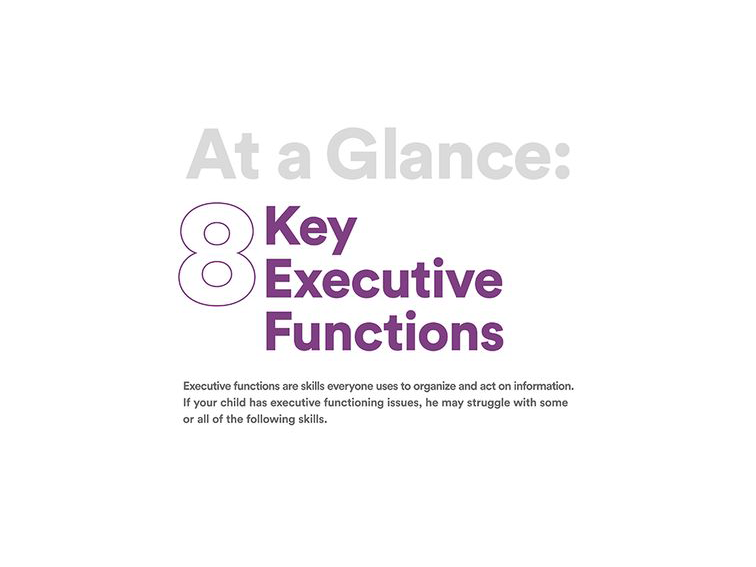
8 Strategies To Improve Executive Functions Of The Brain
by TeachThought Staff
What are the executive functions of the brain, and what can you do as an educator to support their development in students?
That’s what the graphic below from understood.org seeks to answer. According to Harvard, “Executive function and self-regulation skills are the mental processes that enable us to plan, focus attention, remember instructions, and juggle multiple tasks successfully. Just as an air traffic control system at a busy airport safely manages the arrivals and departures of many aircraft on multiple runways, the brain needs this skill set to filter distractions, prioritize tasks, set and achieve goals, and control impulses.”
Put simply, these are ‘higher-order’ thinking patterns and skills that allow students to live.
So what can be done to promote their development–and in a way that doesn’t require you to turn from teacher to lab-coated neuroscientist? Below are some ideas to get started.
8 Strategies To Improve Executive Functions Of The Brain
1. Impulse Control
What it means: Impulse control helps a student think before acting.
How it looks: Students with weak impulse control might blurt out inappropriate things. They’re also more likely to engage in risky behavior.
Strategy to improve: Provide students with a “Wait 5” strategy–counting to five before verbally responding to an input in the classroom, and a “Wait 3” in personal conversations to think before speaking in pairs or groups.
2. Emotional Control
What it means: Emotional control helps students keep their feelings in check.
How it looks: Students with weak emotional control often overreact. They can have trouble dealing with criticism and regrouping when things go wrong.
Strategy to improve: Help students see the relationship between thoughts and feelings. As they are able to control and reframe their thinking, their emotions can benefit in parallel.
3. Flexible Thinking
What it means: Flexible thinking allows students to adjust to the unexpected.
How it looks: Students with “rigid”thinking don’t “roll with the punches.” They might get frustrated if asked to think about something from a different angle.
Strategy to improve: Create weekly journal prompts that require students to do exactly that–see things from multiple perspectives. A child drops an ice cream cone in front of their friends. A coach screams at a player. A shy student wins an award–describe these situations from the multiple perspectives of different participants.
4. Working Memory
What it means: Working memory helps students keep key information in mind.
How it looks: Students with weak working memory have trouble remembering directions–even if they’ve taken notes or you’ve repeated them several times.
Strategy to improve: Use memory games or apps like Fit Brains Trainer or Lumosity, or use memory-based team-building games that require students to remember something as part of a classroom activity–names, colors, favorite things, etc., and then celebrate their success.
5. Self-Monitoring
What it means: Self-monitoring allows students to evaluate how they’re doing.
How it looks: Students with weak self-monitoring skills may be surprised by a bad grade or negative feedback.
Strategy to improve: ‘Stop & look’–periodically call out to the class ‘Stop and look’ so that they can intentionally pause at any given moment and assess what they’re doing, how they’re feeling, what their engagement level is, and how they are or aren’t making progress towards a personal goal.
6. Planning & Prioritizing
What it means: Planning and prioritizing help your child decide on a goal and a plan to meet it.
How it looks: Students with weak planning and prioritizing skills may not know which parts of a project are most important.
Strategy to improve: Have students crate mock projects–video games, music albums, books, businesses, apps, etc.–and then map out how they could accomplish that goal, then pair-share that map to open for feedback from partners in the classroom (which also helps with Emotional Control and Flexible Thinking as well).
7. Task Initiation
What it means: Task initiation helps students take action and get started.
How it looks: Students who have weak task initiation skills may freeze up because they have no idea where to begin.
Strategy to improve: Create daily prompts of various tasks to complete, and have students brainstorm different “starting points,” then share out.
8. Organization
What it means: Organization helps your child keep track of things physically and mentally.
How it looks: Students with weak organization skills can lose their train of thought–as well as their cell phone and homework.
Strategy to improve: Organizational apps. Checklists. Planners. Different things work for different students. Experiment, persist, and find what works to help students organize themselves.
